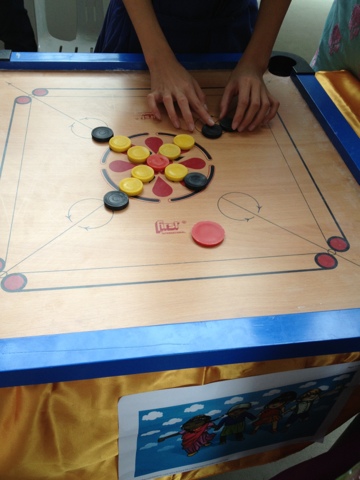St Nicholas is our final stop on our school tour of
Singapore. After a very confusing
beginning (guess you can’t trust GoogleMaps in Singapore J), we arrived! At St Nicholas Girls Primary, we were lucky
to see the same topic taught in different ways to very different learners.
Our visit began with a very special and unique cultural celebration
that was happening that morning on campus for Racial Harmony Day. As we went
into the courtyard, we were greeted by students in traditional outfits and visited
parent volunteers running different booths. We had the pleasure of playing
traditional games from different parts of the world. Also, we were delighted
with a whole plate full of different traditional snacks form Singapore. What an amazing experience!
After enjoying a bit of the celebrations, we continued to
our observations. The first class we saw was a class with students who need
more support, which had fewer than 10 students.
The P5 lesson was an introductory lesson about finding the average. After the first few slides titled “What you
will learn today” and “Expected behaviour during activity time”, the students
were guided to 4 cups of cubes with a different number of cubes in each cup,
and instructed to distribute the cubes equally.
The students used different methods to tactilely find the answer, and
then saw a demonstration on the PowerPoint (I really need to brush up on my PPT
skills; it was amazing!).
Students worked in small groups, then in pairs, and then
individual, with the teacher rotating to assist as necessary. In one example, a cup had 0 cubes, because
the students struggled with the concept of zero. When they discussed it as a whole class, the
teacher introduced the term ‘average’.
She explained that the method she was demonstrating was “a long-winded
method” and pushed the students to find an easier way to solve it. The teacher had the students come up with a
definition of ‘average’ and shared a NON-definition to prevent confusion.
Finally the students were exposed to the formula and asked
to write about it, using a number sentence or words. Students brainstormed when they would use
average in real life and then the teacher gave examples. They revisited the questions from the
beginning of the lecture, and then the teacher had the students start their
homework for a couple of minutes to check for understanding before she sent
them on their way.
Then we saw the same concept taught to an advanced
group. There were over 35 students in
the class. Students were given the task
of measuring each of their hand spans on a piece of string and then dividing
the string equally between the members of the group. They were given 30 minutes of independent
time to complete the task and answer questions.
While they were working, the teacher walked around, asking questions to
push their thinking.
One question really pushed the students to think about
averages. Question 3 asked “If there is
an additional member added to the group, will each pupil’s section of the
string be longer or shorter?” The
discussions stemming from this question were extraordinary. Each student had an idea of the answer, and
was trying to prove it to her classmates.
They tried scenarios with remaining string, and then on the calculator,
before coming to the conclusion that there is no definite answer. The students then explained in writing which
factors would impact the length of the string.
After 30 minutes, the teacher flicked the lights and the
students returned to their seats. The
class went over the worksheet and discussed the different methods that students
used to complete their challenge. They
compared ‘actual length’ and ‘average length’.
It was great to see the different ways to teach the same
concept with rigor and student exploration.
All of the students received the support they needed and were able to
understand the concept with clarity. The amount of teacher talk vs student talk
was very different. The teacher took on the role of the facilitator and
provided experiences for the girls to really discuss this topic. This is something that many teachers struggle
with but it is amazing to see what happens when we let students do the work and
how much deeper their understanding can be.
It was incredible to see this kind of differentiation within
one day. You can tell that teachers truly know their students and are prepared
to provide the instruction that they need.
Furthermore, as we debriefed with the teachers, we heard their detailed
thinking about the misconceptions that their students could have within the
topic of average. Instead of waiting for the misconceptions to emerge, they
provided examples and exercises that would challenge the misconceptions from
the beginning. Like using a set with 0 cubes in the first lesson or asking
those probing questions within the hand span lesson. We know it takes years of
practice to get to this high level of teaching, but we also must urge our
administrators and fellow teachers for the professional development to push our
own understanding of mathematics.
We want to thank the staff and teachers at St. Nicholas from
the bottom of our hearts for such an enriching cultural and professional experience!
It was incredibly insightful to sit with so many teachers at your school and
discuss education on both sides on the Pacific. We look forward to future
conversations on mathematics education!
Playing traditional games at the Racial Harmony Celebration
First observation: hands on approach to finding the average
Group work
Pair work
Teacher summary of what they found
Provides definition after the hands on experience
Real Life Application- What was the average amount of money we spent at the canteen (cafeteria) today?
Second Lesson- Average Hand Span
Girls measuring and cutting the string
The wonderful St. Nicholas Staff














No comments:
Post a Comment